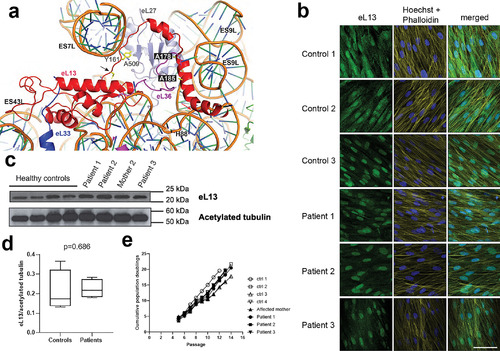Fig. 3
- ID
- ZDB-FIG-210324-45
- Publication
- Costantini et al., 2020 - Novel RPL13 variants and variable clinical expressivity in a human ribosomopathy with spondyloepimetaphyseal dysplasia
- Other Figures
- All Figure Page
- Back to All Figure Page
|
Expression of the eL13 protein in dermal fibroblasts from mutation?positive and control subjects. (A) Ribbon representation of eL13 bound to the human 60S subunit (based on pdb code 4V6X). Residues in eL13 targeted by the two missense mutations are highlighted in black boxes. The starting position of the affected region caused by the intronic mutation at N159 (p.N159_V160ins18) (black arrow) and the potentially disrupted interaction between Y161 and nucleotide A509 are highlighted. The start of the frameshift deletion harbored by our zebrafish model, p.L191Afs*32, which occurs at the point where the C?terminal ??helix of eL13 binds to the rRNA, is also marked (red arrow). Ribosomal proteins that interact with eL13 (red) include eL33 (blue), eL36 (purple), or eL27 (gray) are shown. Figure was generated using the PyMOL molecular graphics system, version 2.0.7 (Schrödinger, LLC). (B) Representative immunofluorescence images of dermal fibroblasts from patients and healthy controls showing staining for eL13 (column 1), structural dyes Hoechst and Phalloidin (column 2), and merged (column 3). Scale bar = 30 ?m. (C) Western immunoblotting (WB) demonstrated expression of the eL13 protein in dermal fibroblasts from mutation?positive subjects at similar levels as in fibroblasts from control subjects. Acetylated tubulin was used as a loading control. (D) Densitometry analysis of the immunoblot confirmed the lack of significant differences?in eL13 expression (mean?±?SD, Student's t test). (E) Dermal fibroblasts from patients and controls showed similar growth kinetics over time in culture. Control 1 = male, age 29?years; control 2 = female age 30?years; control 3 = male age 17?years; control 4 = female age 31 years. |

